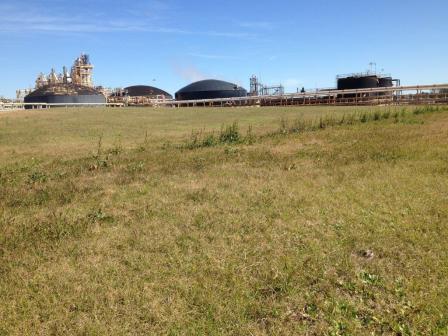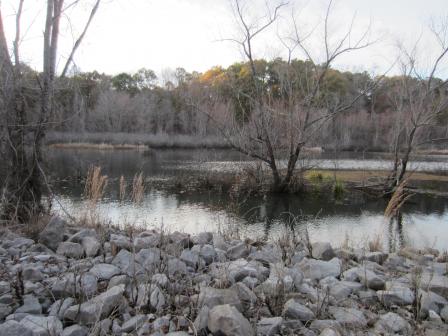Superfund Sites in Reuse in Alabama
If you are having trouble viewing the map in your browser, click the 'View larger map' link below
American Brass Inc.
The 148-acre American Brass Inc. (ABI) Superfund site is located in Henry County, Alabama. The site includes a 24-acre area where ABI operated a secondary brass smelter and foundry between 1978 and 1992. Facility operations resulted in soil, sediment and groundwater contamination with heavy metals. EPA placed the site on the National Priorities List (NPL) in 1999. Cleanup included the excavation and off-site disposal of contaminated soil and sediment. Groundwater monitoring is ongoing while in 2018, a restrictive covenant was finalized restricting the use of the contaminated shallow groundwater. The northern part of the site is vacant. Peanuts are grown on the southern half of the site.
Last updated September 2019
As of December 2019, EPA did not have economic data related to on-site businesses, or economic data were not applicable due to site use. For additional information click here.
For more information:
Capitol City Plume 
 Capitol City PlumeThe Capitol City Plume Superfund site is located in Montgomery, Alabama. The site includes a large area of soil and groundwater contamination near the city of Montgomery’s (the City) public water supply well field. EPA proposed the site for listing on the National Priorities List (NPL) in 2000. Primary site contaminants include chemicals commonly used in dry cleaning, commercial printing and machine parts cleaning. The City is working closely with EPA to assess the groundwater contamination and develop a cleanup plan. Cleanup activities completed to date include removal of contaminated soil and groundwater monitoring. In 2010, the City planted 2 acres of poplar trees. These trees take up and break down contaminants from shallow groundwater. The City used EPA pilot funds to investigate reuse options and coordinate with EPA on the site’s future land use. The City is also in the process of integrating the site’s reuse plan with the City’s master plan for riverfront development. Riverfront redevelopment has already helped revitalize commercial and open space areas as part of the downtown’s Riverfront Amphitheater and Conference Complex. Downtown Montgomery remains open for business during the site’s groundwater cleanup. Land uses include retail districts, neighborhoods, parks, offices and industrial areas. The revitalization of Montgomery’s downtown is a major community priority. Referred to as the “Heart of the City,” recent Montgomery redevelopment projects include the Montgomery Biscuits minor league baseball stadium, retail centers, downtown apartments and restaurants. Much of the site area above ground remains in continued use.
Capitol City PlumeThe Capitol City Plume Superfund site is located in Montgomery, Alabama. The site includes a large area of soil and groundwater contamination near the city of Montgomery’s (the City) public water supply well field. EPA proposed the site for listing on the National Priorities List (NPL) in 2000. Primary site contaminants include chemicals commonly used in dry cleaning, commercial printing and machine parts cleaning. The City is working closely with EPA to assess the groundwater contamination and develop a cleanup plan. Cleanup activities completed to date include removal of contaminated soil and groundwater monitoring. In 2010, the City planted 2 acres of poplar trees. These trees take up and break down contaminants from shallow groundwater. The City used EPA pilot funds to investigate reuse options and coordinate with EPA on the site’s future land use. The City is also in the process of integrating the site’s reuse plan with the City’s master plan for riverfront development. Riverfront redevelopment has already helped revitalize commercial and open space areas as part of the downtown’s Riverfront Amphitheater and Conference Complex. Downtown Montgomery remains open for business during the site’s groundwater cleanup. Land uses include retail districts, neighborhoods, parks, offices and industrial areas. The revitalization of Montgomery’s downtown is a major community priority. Referred to as the “Heart of the City,” recent Montgomery redevelopment projects include the Montgomery Biscuits minor league baseball stadium, retail centers, downtown apartments and restaurants. Much of the site area above ground remains in continued use.
Last updated September 2019
As of December 2019, EPA had data on 22 on-site businesses. These businesses employed 244 people and generated an estimated $29,760,857 in annual sales revenue. For additional information click here.
For more information:
- Sites in Continued Use: Montgomery Mixed-Use Properties (PDF)(1 pg, 430 K)
- Superfund Site Profile Page
Ciba-Geigy Corp. (McIntosh Plant) 
The 1,500-acre Ciba-Geigy Corp. (McIntosh Plant) Superfund site is located in an industrial area 2 miles northeast of McIntosh, Alabama. Beginning in the early 1950s, the plant made several types of chemicals and products, including pesticides, herbicides, insecticides and plastics additives. Site operators improperly disposed of waste in several unlined pits and open landfills. Prior to 1965, they also discharged wastewater into the Tombigbee River. A 1982 EPA site investigation found that site activities had contaminated soil, sediment, sludge, surface water and groundwater with pesticides and chlorobenzene. EPA placed the site on the National Priorities List (NPL) in 1984. Initial cleanup actions began in 1985. Initial cleanup included the removal and treatment of contaminated surface water and groundwater. It also included the closure of surface impoundments and landfills. Cleanup activities between 1989 and 2008 included the continued extraction and treatment of contaminated groundwater; excavation, treatment and disposal of contaminated sludge and soil; land and groundwater use restrictions; a below-ground barrier wall to divert groundwater contamination; and excavation of an area covering about 43 acres of cypress swamp and 3 acres of a ditch. Ciba-Geigy Corporation stopped producing agricultural chemicals in 1999. The Corporation shut down herbicide and insecticide production in 2003. EPA’s cleanup plan was compatible with the continued industrial use of the site. In 2009, BASF Corporation acquired the site property. Today, the company operates a chemical production facility on site and leases part of the property to a nearby business.
Last updated September 2019
As of December 2019, EPA had data on 3 on-site businesses. These businesses employed 855 people and generated an estimated $710,228,000 in annual sales revenue. For additional information click here.
For more information:
Interstate Lead Co. (ILCO)
The 11.5-acre Interstate Lead Co. (ILCO) Superfund site is located in Leeds, Alabama, 15 miles east of Birmingham. From 1970 to 1992, ILCO operated a lead-battery recycling and lead smelting business on the property. Operators at the main facility disposed of processing wastes in piles around the property. In 1983 and 1984, the Alabama Department of Environmental Management (ADEM) conducted site inspections. In 1985, state and federal agencies sued ILCO for improperly disposing of waste on the property. EPA placed the site on the National Priorities List (NPL) in 1986. The ILCO facility ended operations in 1992. EPA then removed toxic waste from the site. The cleanup focused on contaminated soils and groundwater at the main facility, satellite locations and nearby waterways. ILCO’s cleanup activities at the site are ongoing, under EPA and ADEM supervision. The main facility is currently vacant and fenced. ILCO and the Interstate Trucking Company, an affiliated company, still own the main facility and one satellite location, a parking lot across the street. Land at other satellite locations supports many uses, including homes, a restaurant, an industrial business, a church and a gas station.
Last updated September 2019
As of December 2019, EPA had data on 5 on-site businesses. These businesses employed 19 people and generated an estimated $7,460,000 in annual sales revenue. For additional information click here.
For more information:
Olin Corp. (McIntosh Plant) 
 Olin Corp. (McIntosh Plant)The 1,150-acre Olin Corp. (McIntosh Plant) Superfund site is located near the Tombigbee River in McIntosh, Alabama. Olin Corporation has operated a chemical manufacturing facility on site since 1952. Until 1974, the facility disposed of wastewaters in the Tombigbee River. The facility also disposed of solid waste in on-site landfills, ponds, plant areas and a drainage ditch. These activities resulted in groundwater contamination. EPA placed the site on the National Priorities List (NPL) in 1984. Cleanup included groundwater removal and treatment. Cleanup actions also involved upgrading the landfill cap. Groundwater monitoring is ongoing. Land and groundwater use restrictions are in place. A fish consumption advisory is in effect for part of the Tombigbee River near the site. EPA issued an additional cleanup plan in 2014 to address remaining contamination in the floodplain next to the Tombigbee River. Olin Corporation continues to operate its chemical manufacturing facility on site. A second business, Praxair, as well as a church and a natural gas storage facility are also located on site.
Olin Corp. (McIntosh Plant)The 1,150-acre Olin Corp. (McIntosh Plant) Superfund site is located near the Tombigbee River in McIntosh, Alabama. Olin Corporation has operated a chemical manufacturing facility on site since 1952. Until 1974, the facility disposed of wastewaters in the Tombigbee River. The facility also disposed of solid waste in on-site landfills, ponds, plant areas and a drainage ditch. These activities resulted in groundwater contamination. EPA placed the site on the National Priorities List (NPL) in 1984. Cleanup included groundwater removal and treatment. Cleanup actions also involved upgrading the landfill cap. Groundwater monitoring is ongoing. Land and groundwater use restrictions are in place. A fish consumption advisory is in effect for part of the Tombigbee River near the site. EPA issued an additional cleanup plan in 2014 to address remaining contamination in the floodplain next to the Tombigbee River. Olin Corporation continues to operate its chemical manufacturing facility on site. A second business, Praxair, as well as a church and a natural gas storage facility are also located on site.
Last updated September 2019
As of December 2019, EPA had data on 4 on-site businesses. These businesses employed 211 people and generated an estimated $431,678,000 in annual sales revenue. For additional information click here.
For more information:
Perdido Ground Water Contamination
The 110-acre Perdido Ground Water Contamination Superfund site is located near the intersection of Highways (County Roads) 47 and 61 in Perdido, Alabama. In 1965, a train derailed, spilling benzene into the ditch along Highway 61. In 1981, the Alabama Department of Public Health documented reports of odors in residents’ drinking water wells. Sampling confirmed benzene contamination in groundwater. Seaboard System Railroad, now CSX Transportation, is the potentially responsible party (PRP) for the site. The PRP volunteered funds to extend a water line six miles from the nearby town of Atmore to the site. The water line connected about 150 Perdido homes within one mile of the derailment to the public water system. The PRP completed the water line in 1983. Also in 1983, EPA listed the site on the National Priorities List (NPL). Cleanup activities included pumping and treating contaminated groundwater. Site cleanup goals have been met and there are no restrictions on site uses. EPA deleted the site from the NPL in 2017. The site remains in continued residential use. Public service facilities on site include a United States Postal Service office and a fire department. A commercial business specializing in resale merchandise is also on site.
Last updated September 2019
As of December 2019, EPA had data on 6 on-site businesses. These businesses employed 15 people and generated an estimated $332,782 in annual sales revenue. For additional information click here.
For more information:
Stauffer Chemical Co. (Lemoyne Plant)
The 730-acre Stauffer Chemical Co. (LeMoyne Plant) Superfund site is located in Axis, Alabama. The Stauffer Chemical Company began operating a chemical manufacturing facility on site in the 1950s. From 1965 to 1979, waste disposal on site contaminated soil, sediment, groundwater and fish in nearby Cold Creek Swamp. EPA placed the site on the National Priorities List (NPL) in 1984. Site investigations and cleanup activities have focused on three operable units (OUs). OU1 addresses groundwater contamination, OU2 addresses the contamination source, and OU3 addresses contamination of surface water and sediment in Cold Creek Swamp. Cleanup activities are ongoing. The Alabama Department of Public Health placed a fish advisory on Cold Creek Swamp. Placement of an engineered cap on 17.5 acres of Cold Creek Swamp finished in 2015. Nouryon currently owns the site property and manufactures chemicals at the site. Eastman Chemicals also operates on site.
Last updated September 2019
As of December 2019, EPA had data on 2 on-site businesses. These businesses employed 179 people and generated an estimated $160,277,778 in annual sales revenue. For additional information click here.
For more information:
Triana/Tennessee River
 Triana/Tennessee RiverThe Triana/Tennessee Superfund site is located in Huntsville, Alabama. The Olin Corporation operated a dichloro-diphenyl-trichloroethane (DDT) pesticide manufacturing plant on site from 1947 to 1970. Waste handling practices resulted in DDT contamination of soil, sediment, surface water and fish. The site consists of the 11-mile stretch of the Huntsville Spring Branch and Indian Creek tributaries of the Tennessee River. EPA placed the site on the National Priorities List (NPL) in 1983. Cleanup activities finished in 1988. Cleanup included burying contaminated sediments, rerouting a stream channel, digging a new stream channel, and water diversion structures. Per a 1983 Consent Decree, the Olin Corporation conducted long-term fish monitoring annually from 1988 to 2015. The site is located within the Wheeler National Wildlife Refuge and the Redstone Arsenal. Created in 1938, the Refuge provides habitat for migrating birds and many other species. The Arsenal is home to the U.S. Army Aviation and Missile Command and other defense-related agencies.
Triana/Tennessee RiverThe Triana/Tennessee Superfund site is located in Huntsville, Alabama. The Olin Corporation operated a dichloro-diphenyl-trichloroethane (DDT) pesticide manufacturing plant on site from 1947 to 1970. Waste handling practices resulted in DDT contamination of soil, sediment, surface water and fish. The site consists of the 11-mile stretch of the Huntsville Spring Branch and Indian Creek tributaries of the Tennessee River. EPA placed the site on the National Priorities List (NPL) in 1983. Cleanup activities finished in 1988. Cleanup included burying contaminated sediments, rerouting a stream channel, digging a new stream channel, and water diversion structures. Per a 1983 Consent Decree, the Olin Corporation conducted long-term fish monitoring annually from 1988 to 2015. The site is located within the Wheeler National Wildlife Refuge and the Redstone Arsenal. Created in 1938, the Refuge provides habitat for migrating birds and many other species. The Arsenal is home to the U.S. Army Aviation and Missile Command and other defense-related agencies.
Last updated September 2019
As of December 2019, EPA had data on 2 on-site businesses. EPA did not have further economic details related to these businesses. For additional information click here.
For more information:
